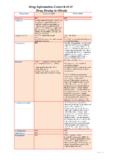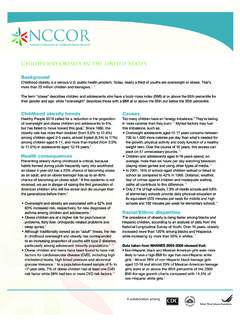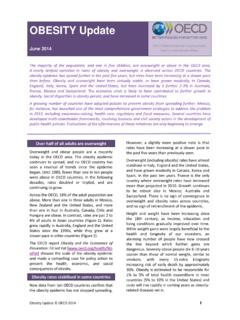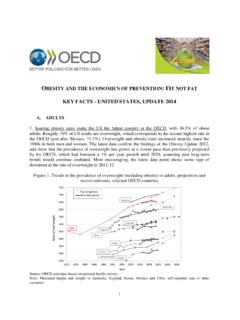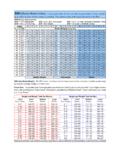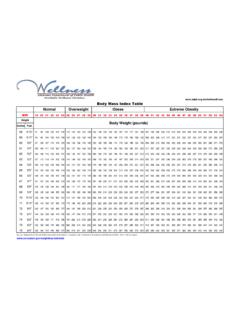Transcription of Dietary Supplementation of …
1 Functional Foods in Heals and Disease 2011; 5:199-213 Page 199 of 213 Research Open Access Dietary Supplementation of fructooligosaccharides reduces Hepatic Steatosis Associated with Insulin Resistance in Obese Zucker Rats Lydia Kaume, William Gilbert, Vidya Gadang, *Latha Devareddy Food Science Department, University of Arkansas, 2650 N. Young Avenue, Fayetteville AR, 72704, USA *Corresponding author: Latha Devareddy, PhD, Department of Food Science, University of Arkansas, Fayetteville, AR, USA Running title: fructooligosaccharides and Obesity Submission date: February 27, 2011; Acceptance date: May 23, 2011; Publication date: May 24, 2011 Abstract Background: One in five adults in the United States is obese as defined by a body mass index of 30 kg/m2. Obesity is associated with metabolic syndrome, a combination of medical conditions including cardiovascular disease, type 2 diabetes, hypertension, hypercholesterolemia, and hypertriglyceridemia.
2 These conditions present challenges to the medical care system and require a multifaceted approach through a variety of interventions. This study investigated the effects of fructooligosaccharides (FOS) at the level of 5 % (w/w) in alleviating the complications associated with metabolic syndrome. Methods: The study was carried out using thirty-six, three-month old female lean and obese Zucker rats housed in an environmentally controlled laboratory. The Zucker rats were divided into three groups (N=12): Lean (L-CTRL) and obese controls (O-CTRL) and obese-FOS (O-FOS). The controls received AIN-93M purified rodent diet and the animals in the O-FOS group were fed AIN-93M diet modified to contain FOS (w/w). After 100 days of treatment, the rats were fasted for 12 hours and sacrificed. Tissue and organs of interest, and blood were collected for analysis. Serum concentrations of the following were determined: glucose, glycosylated hemoglobin (HbA1c), total cholesterol (TC), low-density lipoprotein-cholesterol (LDL-C), high-density lipoprotein-cholesterol (HDL-C), triglycerides (TG), and insulin.
3 Gravimetric quantification of liver lipids was performed and peroxisome proliferator-activated receptor- (PPAR- ) gene expression was determined in white adipose tissue by qRT-PCR. Functional Foods in Heals and Disease 2011; 5:199-213 Page 200 of 213 Results: No significant differences were observed in the serum lipids, fasting blood glucose, HbA1c and PPAR- gene expression in white adipose tissue of O-FOS group compared to O-CTRL group. FOS Supplementation significantly lowered the percent total liver lipids by 12% with a subsequent reduction in the liver weights compared to O-CTRL rats. Serum insulin concentrations were lowered fold in O-FOS group compared to O-CTRL (P < ). Conclusion: Based on these findings we conclude that Dietary Supplementation of 5% FOS (w/w) may reduce hepatic steatosis and the risk for non-alcoholic fatty liver disease (NAFLD) associated with insulin resistance without changes in blood lipids and glucose levels.
4 Key words: Dietary fiber, Fructooligosaccharide, Hepatosteatosis, Liver lipids, Non-alcoholic fatty liver disease (NAFLD), Zucker. Background: The prevalence of obesity in both adults and children has doubled in the past two decades and is now recognized as a global pandemic affecting both developed and developing nations [1]. One in five adults in the United States is obese as defined by a body mass index of 30 kg/m2 [2] Obesity is associated with several chronic diseases such as cardiovascular disease (CVD), type 2 diabetes, hypertension, hypercholesterolemia, and hypertriglyceridemia [3]. These myriad of conditions present a major challenge to the medical care system and requires a multifaceted approach through a variety of interventions. Pharmacological approaches use prescription drugs such as those that may inhibit cholesterol synthesis or regulate hormones such as insulin [4] and important nuclear receptors such as peroxisome proliferator-activated receptor- (PPAR- ) [5].
5 Currently, there is an increased search for safe and effective alternatives to pharmacological interventions including increased physical activity integrated with changes in the diet. Dietary interventions such as low-fat diets, calorie restricted diets, and Dietary fiber supplementations are strategies focused on preventing obesity related risk factors. In particular, Dietary fiber modulates insulin secretion and regulates circulating insulin levels, which play a critical role in glucose homeostasis and management of diabetes type 2 [6]. In addition, there is evidence that Dietary fiber incorporated in healthy diets increases satiety value, provides bulk to stool, decreases intestinal transit time, and reduces the risk for colon cancer [7]. Short chain fructooligosccharide (FOS) is a soluble fiber, inulin-like fructan with prebiotic properties and is low caloric value, approximated as 0-3 Kcal/g of sugar substitute [8].
6 FOS are oligomers of fructose composed of short chains of approximately 3-6 units of fructose units bound by -(2-1) linkages attached to a terminal glucose unit [9]. They are found in many edible plants such as onions, artichokes, chicory, asparagus, wheat, and many other plants rich in inulin [9]. Several studies have used Dietary FOS at the level of 5-10% to investigate its effect on gastrointestinal benefits, weight and fat mass loss mechanisms, and lipid metabolism [10-13]. Although 10% FOS was reported to have undesirable effects such as decreased short chain fatty Functional Foods in Heals and Disease 2011; 5:199-213 Page 201 of 213 acid (SCFA) concentration, and excessive enlargement of the caecum tissue in rat models [14], the dose has been effective in lowering plasma glucose and reducing triglyceride concentration in liver[15,16]. However, 5% of soluble Dietary fiber is a feasible amount of daily intake since FOS is found in small amounts in natural food sources [9] and Supplementation of 5% FOS in human diets has been physiologically effective in improving glucose control, enhancing satiety, nutrient absorption and improving fecal bulking [9].
7 However findings on the potential lipid lowering effects of FOS are both limited and inconsistent in obese states in both animal models and humans [13, 17, 18]. Therefore this study investigates the effects of supplementing 5% FOS (w/w) in improving serum and liver lipid profiles, serum glucose and PPAR- gene expression in white adipose tissue of fa/fa Zucker rats. Methods Animals and diets Thirty-six, three-month old female lean and obese Zucker rats (Harlan, Indianapolis, IN) were housed in an environmentally controlled laboratory. The animals were housed in plastic cages in pairs at a room temperature of 22 1 C under a 12-h light dark cycle. The study was carried out in accordance with the regulations for humane treatment of animals set by the University of Arkansas Institutional Animal Care and Use Committee. The rats were pair-fed to the mean intake of the L-CTRL group and the food intake was measured three times a week. Pair-feeding was necessary to match the macronutrient intake of all the groups.
8 Food intake was monitored three times a week and the rats had free access to deionized water. Animals were weighed once a week, and were on treatment for 100 days. The Zucker rats were divided into three groups (N=12). The rats in the lean and obese control groups were fed AIN-93M purified rodent diet. The groups were as follows: lean + control diet (L-CTRL), obese + control diet (O-CTRL) and obese + 5% FOS (w/w) (O-FOS). The rats in FOS group received a purified diet modified to contain 5% of short chain FOS (w/w). FOS P-95 provided by NutraFlora contains more than 95 percent fructooligosaccharides [comprised of 50% nystose (GF3), 35% kestose (GF2), and 10% fructosynlnystose (GF4)], less than 5% glucose+fructose+sucrose, less than 5% moisture, and less than ash (NutraFlora GTC Nutrition, Golden CO). Diet composition of the treatment and control groups is shown in Table 1. Animal necropsy and sample processing After 100 days of treatment, the rats were fasted for 12 hours before being anesthetized with a mixture of ketamine and xylazine, 70 mg and 3 mg/kg body weight, respectively, and sacrificed by exsanguination via cardiac puncture.
9 Tissue and organs of interest were collected and flash frozen before being stored at -80 C. A small aliquot of whole blood was stored in a microtube containing EDTA for later determination of HbA1c, while the remainder of the blood collected Functional Foods in Heals and Disease 2011; 5:199-213 Page 202 of 213 from the animal during sacrifice was centrifuged at 3000xg for 20 minutes at 4 C to separate serum from whole blood. Aliquots of serum were stored at -80 C until further analysis. Table 1: Diet composition of the control and FOS diet fed to Zucker rats aDiet ingredients were purchased from Harlan Laboratories Inc., (Indianapolis, IN) unless otherwise noted. bThe estimate of caloric content was based on the standard physiological fuel values for carbohydrate, fat, and protein of 4, 9 and 4, respectively. cCTRL = Control Diet dFOS = FOS diet fTBHQ = tertiary-butylhydroquinone, an antioxidant required to prevent lipid oxidation Purchased from ACROS Organics (New Jersey, USA) Serum biochemistry An ACE Alera clinical chemistry system (Alfa Wassermann diagnostic technologies, West Caldwell, NJ) calibrated against manufacturer standards and subjected to regular quality control checks was used to determine the serum concentrations of the following: glucose, glycosylated hemoglobin (HbA1c), total cholesterol (TC), low-density lipoprotein-cholesterol (LDL-C), high-Ingredientsa (g/1000 g) CTRLc FOSd Total energyb, kcal 4004 4004 Cornstarch 436 436 Maltodextrin 155 155 Sucrose 100 50 FOS 0 50 Casein 170 170 Soybean oil 40 40 Cellulose 50 50 AIN-93-VX vitamin mix 10 10 AIN-93M-MX mineral mix 35 35 TBHQf L-Cysteine Choline bitartrate Functional Foods in Heals and Disease 2011.
10 5:199-213 Page 203 of 213 density lipoprotein-cholesterol (HDL-C), and triglycerides (TG). Commercially available kits from Alfa Wassermann diagnostic technologies (West Caldwell, NJ) were used following manufactures instructions. Liver lipids and cholesterol Liver lipids were extracted and gravimetric quantification was performed using Folch s method [19] of lipid extraction. One gram of liver was homogenized in a 20-fold volume of 2:1 chloroform-methanol (v/v) mixture. Following homogenization, NaCl solution was added to achieve separation of the phases and centrifuged for 20 min at 500xg. Supernatant was discarded and the organic phase was filtered and washed with chloroform through fat free filter paper ( cm Whatman, Whatman International Ltd, Maidstone, England). The filtered organic phase containing the tissue lipids was then transferred to a scintillation vial and weighed. Liver total cholesterol was determined using the method described by Searcy and Bergquist [20].

